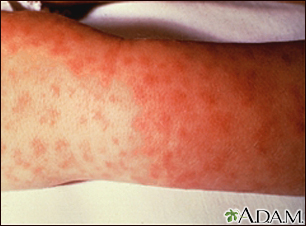Rocky Mountain spotted fever
Spotted fever
Rocky Mountain spotted fever (RMSF) is a disease caused by a type of bacteria carried by ticks.
Images








I Would Like to Learn About:
Causes
RMSF is caused by the bacterium Rickettsia rickettsii (R Rickettsii), which is carried by ticks. The bacteria is spread to humans through a tick bite.
In the western United States, the bacteria are carried by the wood tick. In the eastern US, they are carried by the dog tick. Other ticks spread the infection in the southern US and in Central and South America.
Contrary to the name "Rocky Mountain," most recent cases have been reported in the eastern US. States include North and South Carolina, Virginia, Georgia, Tennessee, and Oklahoma. Most cases occur in the spring and summer and are found in children.
Risk factors include recent hiking or exposure to ticks in an area where the disease is known to occur. The bacteria are unlikely to be transmitted to a person by a tick that has been attached for less than 20 hours. Only about 1 in 1,000 ticks carry the bacteria. Bacteria can also infect people who crush ticks they have removed from pets with their bare fingers. Not all people will remember getting a tick bite.
Symptoms
Symptoms usually develop about 2 to 14 days after the tick bite. They may include:
- Chills and fever
- Confusion
- Headache
- Muscle pain
- Rash -- usually starts a few days after the fever; first appears on wrists and ankles as spots that are 1 to 5 mm in diameter, then spreads to most of the body. Some infected people don't get a rash.
Other symptoms that may occur with this disease:
- Diarrhea
- Light sensitivity
- Hallucinations
- Loss of appetite
- Nausea and vomiting
- Abdominal pain
- Thirst
Exams and Tests
Your health care provider will perform a physical examination and ask about your symptoms.
Tests that may be done include:
- Antibody titer by complement fixation or immunofluorescence
- Complete blood count (CBC)
- Kidney function tests
- Partial thromboplastin time (PTT)
- Prothrombin time (PT)
- Skin biopsy taken from the rash to check for R. rickettsii
- Urinalysis to check for blood or protein in the urine
Treatment
Treatment involves antibiotics and carefully removing the tick from the skin. To get rid of the infection, antibiotics such as doxycycline or tetracycline need to be taken. Pregnant women are usually prescribed chloramphenicol.
Outlook (Prognosis)
Treatment usually cures the infection. About 3% of people who get this disease will die.
Possible Complications
Untreated, the infection may lead to health problems such as:
- Brain damage
- Clotting problems
- Heart failure
- Kidney failure
- Lung failure
- Meningitis
- Pneumonitis (lung inflammation)
- Shock
When to Contact a Medical Professional
Contact your provider if you develop symptoms after exposure to ticks or a tick bite. The complications of untreated RMSF are often life threatening.
Prevention
When walking or hiking in tick-infested areas, tuck long pants into socks to protect the legs. Wear shoes and long-sleeved shirts. Ticks will show up on white or light colors better than on dark colors, making them easier to see and remove.
Remove ticks immediately by using tweezers, pulling carefully and steadily. Insect repellent may be helpful. Because only about 1 in 1,000 ticks carry this infection, antibiotics are not usually given after a tick bite.
Related Information
Tick biteRespiratory
Heart failure
Meningitis
References
Blanton LS, Walker DH. Rickettsia rickettsii and other spotted fever group rickettsiae (Rocky Mountain spotted fever and other spotted fevers). In: Bennett JE, Dolin R, Blaser MJ, eds. Mandell, Douglas, and Bennett's Principles and Practice of Infectious Diseases. 9th ed. Philadelphia, PA: Elsevier; 2020:chap 186.
Bolgiano EB, Sexton J. Tickborne illnesses. In: Walls RM, ed. Rosen's Emergency Medicine: Concepts and Clinical Practice. 10th ed. Philadelphia, PA: Elsevier; 2023:chap 123.
BACK TO TOPReview Date: 5/19/2023
Reviewed By: Jatin M. Vyas, MD, PhD, Associate Professor in Medicine, Harvard Medical School; Associate in Medicine, Division of Infectious Disease, Department of Medicine, Massachusetts General Hospital, Boston, MA. Also reviewed by David C. Dugdale, MD, Medical Director, Brenda Conaway, Editorial Director, and the A.D.A.M. Editorial team.

Health Content Provider
06/01/2025
|
A.D.A.M., Inc. is accredited by URAC, for Health Content Provider (www.urac.org). URAC's accreditation program is an independent audit to verify that A.D.A.M. follows rigorous standards of quality and accountability. A.D.A.M. is among the first to achieve this important distinction for online health information and services. Learn more about A.D.A.M.'s editorial policy, editorial process and privacy policy. A.D.A.M. is also a founding member of Hi-Ethics. This site complied with the HONcode standard for trustworthy health information from 1995 to 2022, after which HON (Health On the Net, a not-for-profit organization that promoted transparent and reliable health information online) was discontinued. |
The information provided herein should not be used during any medical emergency or for the diagnosis or treatment of any medical condition. A licensed medical professional should be consulted for diagnosis and treatment of any and all medical conditions. Links to other sites are provided for information only -- they do not constitute endorsements of those other sites. © 1997- 2025 A.D.A.M., a business unit of Ebix, Inc. Any duplication or distribution of the information contained herein is strictly prohibited.
